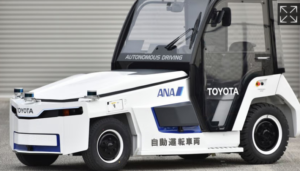Tokyo’s Haneda Airport is pioneering the use of driverless vehicles for cargo transportation as a solution to its worker shortage. Faced with the challenge of finding staff to meet the demands of increasing tourist numbers, airport authorities have turned to automation and advanced technology.
As one of the busiest airports in the world, Haneda serves millions of passengers annually. All Nippon Airways (ANA) and Toyota Industries have jointly introduced a driverless vehicle capable of transporting containers weighing up to 13 tons at once. According to a statement by both companies, this cutting-edge vehicle is also equipped to pull six containers simultaneously, significantly enhancing efficiency.
The vehicle can cover the two-kilometer distance between the aircraft and the airport building autonomously, without the need for a human driver. This makes cargo transportation not only faster but also more reliable and less dependent on human resources.
This vehicle can pull six containers at a time. This self-driving car can easily cover a distance of about two kilometers between the aircraft and the airport building without a driver.
The self-driving vehicle is classified as ‘Level Four,’ meaning it requires no human intervention to operate under normal conditions. However, a person can assume manual control if necessary. These vehicles have been operational at Haneda Airport since July, forming a key part of the airport’s broader aviation sector modernization program. The goal is to enhance logistics, improve safety, and reduce delays in the handling of goods and cargo.
In the context of growing international tourism, Japan’s aviation sector faces significant challenges. Kansai Airport in Osaka has long prided itself on never losing a passenger’s bag. However, with the sharp rise in tourists, maintaining such impeccable standards is becoming increasingly difficult. Japan aims to double its annual tourist numbers to 60 million by 2030, putting further pressure on airports to innovate.
Additionally, Japan’s aging population adds to the strain. With a significant portion of the workforce over the age of 65, many industries, including transportation and logistics, are facing a shortage of workers. Driverless technology is seen as a vital solution to these demographic challenges, ensure that the country’s infrastructure can cope with future demands.
Japan is no stranger to the development of autonomous vehicles. Trials for self driving cars on public roads have been ongoing for years, and since last year, ‘Level Four’ vehicles fully legalized for use on Japan’s public roads.
The country continues to push the boundaries of technology, seeking new ways to maintain its reputation for precision, efficiency, and technological leadership in the face of mounting challenges.
The introduction of driverless cars in airports is expected to revolutionize the aviation sector, improving operations and setting a global benchmark for other countries grappling with similar issues.
